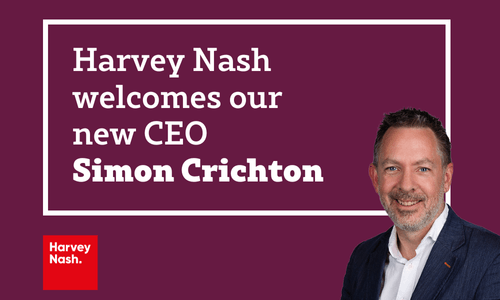
Meet our team
Ever dreamed of having a job you love?

News & Insights
Computer Weekly/Harvey Nash Diversity in Tech Conference 2025: Highlights
Taking place on the 6th November, the annual Computer Weekly/Harvey Nash Diversity in Tech Conference 2025 once again brought together tech profession...
A turning point in the AI talent race
In a recent piece for Computer Weekly, Simon Crichton, Harvey Nash CEO, argues that the U.S. decision to hike visa fees for skilled workers may mark a...
Nash Squared Announces Integration of Spinks Brand into Harvey Nash
Nash Squared, the global leader in technology and talent solutions, today announced the integration of the Spinks brand into Harvey Nash, its speciali...
Web Summit Lisbon 2025 Recap
Harvey Nash proudly represented the intersection of talent, technology, and sustainability at Web Summit Lisbon 2025. Nash Squared’s Group Technology ...
Leading global teams in the age of AI
Andy Heyes, Managing Director UK&I & Central Europe, was recently featured in the Silicon article From Gap to Growth: How Enterprises Are Rethinking T...
Digital leadership in Scotland
FutureScot’s recent article, AI, efficiency and the next wave of digital leadership in Scotland, explores how Scotland’s public sector is responding t...
Why data roles are at the heart of the AI boom
Data roles are becoming increasingly critical as organisations look to harness AI effectively. The demand for professionals skilled in managing, struc...
AI and Machine Learning Trends 2025: A UK Hiring Outlook
Artificial Intelligence (AI) and machine learning (ML) have moved rapidly from experimental projects to mainstream business priorities in the UK. Orga...
How is AI reshaping entry-level cybersecurity hiring?
Mo Gaibee, Associate Consultant at Harvey Nash, was recently featured in a CSO Online article exploring how AI is reshaping entry-level cyber hiring a...
Leeds Digital Festival 2025: Round Up
This year marked a special milestone for Leeds Digital Festival, its 10th anniversary. Over two weeks, the city came alive with events celebrating inn...
Exploring the AI energy crisis: Leeds Digital Festival 2025
On 25th September, we were delighted to host an event as part of Leeds Digital Festival’s 10th anniversary celebrations, a two-week programme showcasi...
6 top tips to land your next tech role
The tech recruitment market has grown more competitive in recent years, with economic uncertainty, rising costs and offshore hiring affecting opportun...
Harvey Nash Appoints Simon Crichton as CEO to Drive Next Phase of Growth
Technology recruitment specialist strengthens leadership team with proven industry executive as company advances growth strategy
LONDON, 30th Septe...
Tech Talks: Will Abbey, COO, ARM
ARM's Will Abbey: From Ghana to Silicon Valley
What shapes a global tech leader?
ARM's CCO Will Abbey shares his journey from Ghana to the UK and Cal...
Tech Talks: Veronica Celis Vergara, Founder, Valumia
Why I keep coming back to entrepreneurship, even when it hurts
Veronica (founder of Valumia) is a seasoned entrepreneur who has returned to the startu...
How is AI reshaping hiring priorities in tech?
In the fast-moving world of technology, experience used to be the gold standard. Job titles, years in post, and familiarity with established systems o...
Will AI wipe out entry-level jobs?
AI is transforming the workplace, but its impact on entry-level roles is more nuanced than often portrayed. In a recent article for Computer Weekly, A...
Tech Talks: Sacha Michaud, Co-founder, Glovo.
Beyond the Warehouse: Glovo’s Sacha Michaud on Rewriting Retail for Europe
“80% of what we buy is already in our city, we just don’t have visibility.”...
Newcastle Digital Leadership Report launch event highlights
On 11th September 2025, we welcomed digital and business leaders to the Dakota Hotel in Newcastle for our Nash Squared / Harvey Nash Digital Leadershi...
Tech Talks: Ryan Lisk, Founder, Hybrid Legal
When AI Drafts Your Contracts: Ryan Lisk on Trust, Risk & the Future of Law
Hybrid Legal’s Ryan Lisk reveals when AI-drafted contracts go dangerously ...
Tech Talks: John Whitlow, CIO, Nixon Hire
The AI Reality Check: Digital Foundations Still Matter
In this candid Tech Talks conversation, fractional and now permanent CIO John Whitlow offers a ...
Tech Talks: Miha Jagodic, CEO, Bloq.It
From 'Tuna Can Period' Scarcity to Hypergrowth: Bloq.It's Miha Jagodic on Building Green Logistics with Pragmatic Strategy
Today's guest Miha Jagodic,...
Tech Talks: Christopher Lombardi, filmmaker
Revolutionising Indie Film: Christopher Lombardi's Vision for Generative AI in "Princess Halle and the Jester"
In this episode, host David Savage chat...
Peter Kyle outlines the UK’s AI ambitions
On Wednesday, 3rd September, Peter Kyle MP, the Technology Secretary, called on industry to match the UK Government’s ambition on AI in a speech at Ma...
Tech Talks: Peter Kyle MP, Secretary of State
Britain's £44 Billion AI Future: Is Everyone Included?
Secretary of State Peter Kyle MP discusses Britain's record £44 billion AI investment, detailin...
Growing demand for AI-skilled cyber specialists
AI is becoming central to organisations’ digital transformation, and cybersecurity is no exception. In this article for Computer Weekly, Peter Birch, ...
Tech Talks: Sigi Arnason, Nick Gatfield, Overtune
The CapCut for Music: Overtune's Blueprint for Creative Control
Host David Savage sits down with Overtune founder Sigi Arnason and investor Nick Gatfi...
Tech Talks: Christina Lewis, Founder, Herizon
I Used to Change My Accent: Why Emotional Intelligence is Tech's New Power Skill
The tech industry often celebrates speed and disruption. But what hap...
Tech Talks: Kyle Hauptfleisch, Chief Growth Officer, Daemon
AI's Real Challenge: Why Friction Points Trump 'Transformation' Strategy
Organizations are under immense pressure to adopt AI, yet many are missing th...
AI: From pilot to productivity
For many organisations, the AI journey is well underway. Pilots have been launched, internal capabilities have been built, and use cases are being exp...
Tech Flix: Data's Untold Story
The Price of Progress: Tech, Data, and Our Planet
The glittering promise of technological progress, from the entertainment spectacle of Las Vegas's Sp...
Tech Talks: Georgie Kemp, SEO Lead, VEED
The Great Search Rewire: What AI & Video Mean for SEO's Future
SEO is having its most fundamental shift in 25 years. Georgie Kemp, SEO Lead at VEED, u...
Tech Talks: Dr. Vanessa Vallely OBE, Founder, We Are Tech Women
“Last Women Standing": The Fight to Keep Women in Tech on the Map Amidst Funding Cuts
The tech sector is facing a critical challenge: women are increa...
Cybersecurity Trends 2025: A UK Hiring Outlook
Cybersecurity has taken centre stage in the UK this year. With threats growing more sophisticated and regulatory scrutiny tightening, businesses are i...
Tech Talks: Emma Wright, Partner, Crowell & Moring
Cyber War Stories, Supply Chain Blind Spots & Why AI Is the New Risk Frontier
Cyberattacks are no longer an “if”—they’re a “when.” Emma Wright, Partn...
How are employers rethinking talent to keep pace with AI innovation?
The demand for AI skills is outpacing supply at an extraordinary rate. According to the latest Nash Squared/Harvey Nash Digital Leadership Report, 51%...
Leeds Digital Leadership Report launch event highlights
On 16th July 2025, we gathered with some of Yorkshire’s most influential tech leaders to mark the Leeds launch of the Nash Squared / Harvey Nash Digit...
Why Tech Leaders Are Turning to Outsourcing to address skills gaps
Skills shortages continue to stalk the technology industry. Although not as acute as in the post-pandemic period, large proportions of technology lead...
How are tech leaders securing the biggest pay rises?
Harvey Nash’s Helen Fleming, Executive Director, and Peter Birch, Director of Technology and Digital Executive Search recently featured in a Computing...
Tech Talks: Raphael Güller, Chief Product Officer, Sweep
Sustainability Is Good Business—But Show Me the Numbers
Regulation. Data overload. Greenwashing. Welcome to the frontline of corporate sustainability....
Birmingham Digital Leadership Report Launch Event Highlights
On 26th June 2025, we gathered with a brilliant group of digital and business leaders in Birmingham to mark the regional launch of the Harvey Nash Dig...
Tech Talks: Simon Collins, Deputy Head, Bedlington Academy
Lessons in Leadership: What schools can teach the tech industry
David returns to his old school, Bedlington Academy, for a powerful conversation with ...
Digital Leadership Report 2025: London Event Launch Highlights
On 18th June 2025, we gathered with an amazing group of tech and business leaders on our London rooftop to celebrate the launch of the Nash Squared / ...
Tech Talks: Gwyn Williams, UK Sales and Marketing, WellO₂
Just Breathe: Gwyn Williams on Tech, Health and Scaling with Purpose
What if the next innovation in health tech isn’t an app—but a smarter way to inha...
Tech Talks: Fawad Qureshi, Field CTO, Snowflake
Beyond the Buzzwords: AI, Bias and Staying Relevant
If AI feels like it’s moving faster than your ability to keep up—you’re not alone. But according t...
Tech Talks: Becky Case and Ronan Conlon, Rent the Runway
Scaling Fast, Dressing Smart: Engineering lessons from Rent the Runway
What do you get when a fashion disruptor scales into a tech-first logistics mac...
Harvey Nash backs launch of UK Hiring Taskforce at Parliament
On 16th May, Andy Heyes, Managing Director UK&I & Central Europe, joined industry leaders and policymakers at parliament for the official launch of th...
Tech Talks: Robert McArdle, Director, Trend Micro
Cybercrime in the Age of Accelerants
Trend Micro’s Director of Forward-Looking Threat Research, Robert McArdle, joins David to unpack how large-langua...
Tech Talks: Richard Skinner, CEO, Phased AI
The Last Digital Transformation
Richard Skinner, CEO of Phased AI, joins Tech Talks to discuss why the AI revolution may be the final seismic shift in...
Tech Talks: Jared Browne, Head of Privacy and AI Governance, Fexco
Philosophy, Privacy and the Future of AI
In this episode, Jared Browne—philosopher-turned-lawyer and Group Head of Privacy and AI Governance at Fexco—...
TechNExt 2025: Tech Flix goes North
On 17th June, the Harvey Nash Newcastle team attended TechNExt, the North East’s flagship technology festival, bringing together thousands of attendee...
Tech Talks: James Doyle, CEO, iReel
From Touchline to Timeline: James Doyle on AI's Playbook for Sport
James Doyle, CEO of iReel, joins Tech Talks to explore how generative and agentic A...
London Tech Week 2025 - Reflections from David Savage
This year, David Savage, Tech Evangelist at Nash Squared/Harvey Nash, returned to London Tech Week, an event that unites global innovators, investors,...
Financial services seek AI talent
The UK financial services sector is facing its biggest technology skills shortage in over 15 years, driven by rapid advances in AI. Rhodri Hughes, Exe...
Bridging the AI skills gap
Management Today - Five ways to bridge the growing AI skills chasm
In a recent article for Management Today, Ankur Anand, Chief Information Officer, ...
Dublin Tech Summit 2025: Highlights from David Savage
This year, David Savage, Tech Evangelist at Harvey Nash attended Dublin Tech Summit for the first time, immersing himself in the tech community of Ire...
Harvey Nash Digital Leadership Report EMEA webinar
On June 10, 2025, we were proud to host the exclusive launch of the 2025 Harvey Nash Digital Leadership Report. This landmark event brought together a...
How can the public sector overcome its tech talent challenge?
In a recent Computer Weekly article, Graeme McNaull, Executive Director for the Public Sector at Harvey Nash UK&I, shared his perspective on how the p...
Tech Talks: Yvette McGaffin, Co-founder, Reform RX
Reforming Fitness: How Tech is Reshaping Pilates with Data, Design & Mind-Body Impact
David Savage speaks with Yvette McGaffin, co-founder of Reform R...
AI drives biggest tech skills shortage in 15+ years finds Harvey Nash
AI becomes world’s most in-demand tech skill in shortest timeframe
Half of global technology leaders now have an AI skills shortage
Steep rise linke...
Digital Leadership Report 2025
26th edition of the Digital Leadership Report
The 2025 Nash Squared Digital Leadership Report is the world’s largest and longest-running survey of ...
Tech Talks: Sasha Lund, Founder, Core Values Consulting
Dying Changed My Mind: Sasha Lund on Legacy, Leadership & Gut Instinct
Sasha Lund—founder of Core Values Consulting and editor of The Rising Role of W...
No degree? No problem. Why employers are choosing non-graduates?
Is a degree still an essential qualification to have these days? Or are we seeing a major shift in how employers view university degrees. Andy Heyes, ...
Tech Talks: Tom Leathes, CEO and co-founder, Motorway
Building Motorway: From Bootstrapped Grit to a £250M-Backed Unicorn
Tom Leathes, CEO and co-founder of Motorway, joins David Savage to talk about the ...
Tech Talks: Pietro Candela, EMEA General Manager, Alipay+
Beyond Payments: How Alipay+ Is Building a Global Mobile Ecosystem
David Savage sits down with Pietro Candela, EMEA General Manager at Alipay+, to exp...
Tech Talks: Barry O'Connell, SVP, Trustwave
Securing the Supply Chain: Cyber Threats Facing Manufacturing
In this episode of Tech Talks, David Savage reconnects with Barry O’Connell to explore t...
Tech Talks: Svetlana Tarnagurskaja, Co-founder, The Dot Collective
Data with Purpose: Building Value-Driven Infrastructure
In this episode, David Savage speaks with Svetlana Tarnagurskaja, CEO and co-founder of The Do...
Tech Talks: Jason Rees, VP, Oracle
Breaking Down the Walls: AI, Cloud, and the Future of Enterprise Tech
The pace of AI and cloud innovation is relentless—but are enterprises keeping up...
Tech Talks: Feryal Clark
Powering AI for Everyone: The UK’s Blueprint for Clean, Equitable Innovation
In this special episode of Tech Talks, David Savage sits down with Feryal...
AI Energy Council to prepare UK for AI-powered infrastructure
New AI Energy Council holds first round of talks on delivering the power which will drive the UK's AI ambitions.
Technology and Energy Secretaries cha...
Tech Talks: Recorded at Barrafina
Climate Tech & Data: Are Businesses Measuring Sustainability or Just Marketing It?
Sustainability has become a business imperative - but is it driving...
ProductTank Newcastle with guest speaker Viktoria Korzhova
We were delighted to sponsor and host the latest ProductTank Newcastle event last night, welcoming members of the Product Management community from ac...
Tech Talks: Joy Cristea
Breaking Barriers: Diversity, Adaptability, and Growth in Tech
In this episode of Tech Talks, David Savage speaks with Daryl Cromer, CTO of PCs and Sm...
Higher Education Success Story - University of Lancaster
Tailored Talent Solutions to Deliver Lancaster University Digital Transformation Strategy
Lancaster University required support filling key vacanci...
Tech Talks: Oskar Konstantyner, VP, Templafy
AI, Documents & Automation: Are We Finally Getting It Right?
In this episode of Tech Talks, Oskar Konstantyner, VP of Product at Templafy, dives into ...
Tech Talks: Tanya Suarez, Board Chair, GENDEX
Funding the Future: Why Female-Led Startups Still Struggle for Investment
Despite clear evidence that female-led startups generate strong financial re...
Tech Talks: Nikki Camilleri, Director, LCCM
Breaking Into Music: Education, Industry, and the Future of Performance
In this episode of Tech Talks, David Savage speaks with Nikki Camilleri, Music...
Tech Talks: Ari Last, Founder, Bubble
Redifining Childcare: How Bubble is changing the game for parents and caregivers.
Childcare is broken. Parents struggle with accessibility, flexibilit...
Tech Talks: Bonny Simi, President of Operations, Joby Aviation
Leading in Aviation: breaking barriers in a male-dominated industry
In this episode of Tech Talks, host David Savage sits down with Bonny Simi from Jo...
Tech Talks: Napala Pratini, CEO of Habitual
Breaking the Cycle: How Habitual is rethinking weight loss & type 2 diabetes
In this episode of Tech Talks, Napala Pratini, CEO of Habitual, breaks do...
Tech Talks: Leila Woodington, Chief Marketing Officer at VEED
Breaking Barriers: AI, women in video and the future of content creation
In this episode, we welcome Leila Woodington, Chief Marketing Officer at VEED...
NIS-2 Directive: Navigating the new cybersecurity landscape
On Thursday 6th March, Harvey Nash Ireland had the pleasure of hosting Security and Business Leaders from across Ireland at our offices in Merrion Squ...
Neuro-Inclusivity in the Workplace Webinar
In today's rapidly evolving workplace, promoting neuro-inclusivity is not just a matter of compliance but a strategic imperative that fosters innovati...
Tech Talks: Manchester Digital Feast panel discussion
We are delighted to share the full recording of the panel discussion hosted at Manchester Digital Skills Feast as part of their Festival. The evening ...
What is the cloud?
The cloud and it's offering is vast, with its main aim to give organisations the ability to deliver resources and services publicly, privately or in a...
Harvey Nash attends Manchester Digital Skills Feast
Last night, Harvey Nash were delighted to attend the Digital Skills Feast as part of Manchester Digital's Festival, which was sponsored and co-hosted ...
Tech Flix: Founders in the Age of Ai
Is AI distorting and transforming the principals of company building?
The latest Tech Flix documentary hosted by Technology Evangelist David Savage d...
Midlands Digital and Technology Leadership Dinner
Last week Harvey Nash and Nash Tech had the pleasure of hosting 30 digital and technology leaders from across the Midlands at the Bank restaurant in c...
Tech Talks: Zaahirah Adam, Founder of hati
Reinventing dating apps for genuine human connection
In this Tech Talks podcast episode David Savage speaks to Zaahirah Adam, the founder of hati. Zaa...
AI and Robotics: Exploring the Next Frontier with AI
We recently hosted an exclusive event in New York in partnership with NASA's Goddard Space Flight Centre in the USA, where we premiered our latest Tec...
Reignite your tech career: Tips for returning tech professionals
In the ever-evolving tech industry, staying relevant and competitive is crucial. Whether you're returning after a career break or looking to pivot wit...
Edinburgh 25th Digital Leadership Report Dinner
What do digital leaders think of the current technology landscape?
On the 28th of November we hosted our 25th annual Digital Leadership Report din...
What does 2025 hold for the technology recruitment market?
As we enter a new year, I don't think many in the technology recruitment industry will be especially sad to leave 2024 behind.
2024 was quite a chall...
2025 Digital Leadership Report is now open for responses
We're delighted to invite you to take part in the 2025 Digital Leadership Report survey from Harvey Nash, part of Nash Squared, the world’s largest an...
Digital Scotland conference 2024
Harvey Nash exhibits at annual conference for public sector technology professionals
As an exhibitor at Scotland's largest digital transformation sum...
Bev White Named in Global Power 150 Women in Staffing
London, November 20 2024 Bev White, CEO of Nash Squared, the leading technology and talent solutions provider, has been again recognised in Staffing I...
2024 Global Tech Talent & Salary Report
Harvey Nash Global insights, in collaboration with LinkedIn, into the current state of the tech job market, salaries, jobs satisfaction and more.
Harvey Nash win 'Inclusive Recruiter of the Year' 2024 Award
On November 8th, our Harvey Nash Scotland team members came together to celebrate the Scotland Women in Technology Awards Ceremony, held at the Radiss...
Becoming a CIO: Eight tech roles to take you to the top
Becoming a CIO isn't easy. Nor should it be. But for the right person the role of CIO is one of the most valued and rewarding jobs you can have. So, w...
Bev White, Nash Squared CEO, recognised in Staffing 100 Europe List
London, October 24 2024 - Bev White, CEO of the leading global technology and talent solutions provider Nash Squared, has been recognised in the Staff...
Lessons from Olympians for Today’s Business Leaders
Our CEO, Bev White, talks to Olympic silver medallist diver Leon Taylor about the parallels in sport and business. This article first appeared on Comp...
Tech education and talent policy
What should the new government prioritise?
With a new Labour government in place in the UK, Nash Squared CEO, Bev White, looks at the importance of di...
Is diversity (even more) under threat in tech?
Bev White, Nash Squared CEO, looks at the impact of budget constraints on diversity in the tech sector. This article first appeared on ComputerWeekly....
Tech Flix: Tackling underinvestment in female-led business
How can we reverse the chronic lack of investment in female-led businesses?
A strong industry and economy is built on diversity. But since the pandemi...
2024 Leeds Digital Festival Event
We were delighted to host digital leaders from across Leeds during this year's Leeds Digital Festival, as we premiered our last Tech Flix film, “AI & ...
Time to step up in supporting neurodiverse talent at work
Rhona Carmichael, Chief Commercial Officer at Nash Squared and Adam Harper, Software Development Recruitment Consultant at Harvey Nash look at what ca...
Tech Flix: Robotics and AI: A future you're not prepared for
Are robots coming for your job?
Just over half of you feel prepared for the changes being brought about by AI. Our Group Technology Evangelist David ...
Cybersecurity 101: What it is and why it matters
In today's digital age, cybersecurity plays a critical role in safeguarding sensitive information and protecting businesses from cyber threats. As cyb...
Cybersecurity Careers: What to expect and how to navigate your career
What is Cybersecurity?
Cybersecurity is the practice of safeguarding our computer systems, networks, and sensitive data. At its core, it’s the prac...
The Pivotal Role of the Chief Transformation Officer
In the rapidly evolving business and digital landscape, the role of the Chief Transformation Officer (CTrO) has become increasingly significant. As or...
Data & BI Leaders Event 2024
In today's rapidly evolving Data, Analytics & AI market, organizations face a number of challenges that demand creative solutions. Recently, I hosted ...
Exploring the Frontiers of Autonomyevent with AWS
What questions are leaders thinking about now where AI and robotics are concerned?
Last week Amazon Web Services (AWS) teamed up with Harvey Nash to...
Hybrid working demands a proper reset
Andrew Neal, Chief People Officer at Nash Squared, looks at what needs to change to make sure hybrid working is effective for everyone. A version of t...
Leeds 25th Anniversary Digital Leadership Report 2024
What topics are currently at the forefront of the minds of digital leaders? Nash Squared Technology Evangelist, David Savage breaks down the key discu...
Manchester 25th Anniversary Digital Leadership Report 2024
So, what really is on the minds of tech leaders in Manchester?
Well the Digital Leadership Report event, which took place on 27th June, was one ex...
What makes for an effective AI policy?
Nash Squared CIO, Ankur Anand, looks at what different components you need for a good AI policy. This article first appeared on boardagenda.com.
Boar...
Exploring the Project Management Office and Value Management Office
In the dynamic landscape of organisational management, two crucial entities often stand at the forefront: the Project Management Office (PMO) and the ...
Rapid roll out of GenAI, but no signs of 'tsunami' on jobs
Predictions that AI will have a major, rapid effect on jobs appears overhyped
Chief AI Officers are on the up
Tech leaders with a GenAI policy have do...
Digital Leadership Pulse Report
About the Report
This Nash Squared Digital Leadership Report Pulse Survey was created to provide a mid-year update to the Digital Leadership Report w...
Leadership accountability is key to diversifying talent
Nash Squared CEO, Bev White, shares her thoughts on the importance of the senior leadership team of an organisation having an impact on the diversity ...
The launch of 'AI and Robotics: A Near Future You're Not Prepared For'
On the 23rd of May, Nash Squared premiered our latest documentary in the 'Tech Flix' series at the National Robotarium, just outside Edinburgh. This t...
GenAI: what we know and don't know, what excites us, what scares us
Nash Squared Chief People Officer, Andrew Neal, looks at where we are with our understanding of GenAI and why we should be cautious. This article firs...
All change? The CIO challenge in the next five years
What of the CIO? Ankur Anand, CIO at Nash Squared, looks at how the role of the Chief Information Officer has evolved and where it’s heading in the fu...
Harvey Nash announces 2024 contractor award winner
London, [April 2024] Harvey Nash, the leading global technology recruitment business has named Lola Yesufu from Ireland, the winner of its second Glob...
NextGen Success story - FSB Technology
Improving tech diversity through Harvey Nash NextGen solution
FSB Technology is an award-winning sportsbook platform at the forefront of innovation. D...
Higher Education Success story - University of Salford
Redesigning recruitment processes to meet increasing demands for IT skills at University of Salford.
Faced with an increase in demand for specialised...
Higher Education Success Story - University of Edinburgh
Providing a flexible resourcing model for service excellence transformation.
The University of Edinburgh were seeking a recruitment partner to suppor...
Higher Education Success Story - University of Dundee
Securing top talent against challenging market condition to deliver University of Dundee's digital transformation.
The University of Dundee wanted t...
Higher Education Success Story - Heriot Watt
Rapidly sourcing talent to deliver a major transformation programme.
Heriot Watt University embarked on a complex ERP replacement in early 2023 and ...
Five key principles for data insight success
How can you use data to grow your business? Ian Bobbett, Chief Data Officer at Crimson and George Lynch, Head of Tech Advisory at NashTech (both part ...
Going up? Senior tech pay trends – and how to influence them
The last few years have seen a boom in demand for technology services as businesses digitised and transformed following the pandemic. But last year, t...
Celebrating the Strength of Diversity on International Women's
I feel incredibly honoured to have the wonderful task of announcing the winners to the inaugural Nash Squared EmpowHER Inclusion Awards – founded by w...
Staying optimistic on Women’s Day despite slow progress
On International Women's Day, our CEO, Bev White, shares her thoughts on the progress (and lack of!) there has been in the number of women in tech. Th...
Resetting the Exodus Event
Resetting the Exodus: 50% of Women in Tech roles leave by Age 35, what does this mean for the Financial Services Sector?
I was delighted to recently ...
Meet Harvey Nash UK’s Top Contractor of the Year
Harvey Nash, the leading global technology recruitment business has named Manoj Yerra, the winner of its second Contractor of the Year UK Award in rec...
Harvey Nash Ireland announces winner of Contractor of the Year Award
Harvey Nash, the leading global technology recruitment business has named Lola Yesufu, the winner of its Contractor of the Year Ireland Award in recog...
What is Programme and Project Management?
What is project and programme management as a discipline?
This formal management disciplines overall aim is to ensure best practices through the prin...
Help us transform the tech talent pipeline in Birmingham
Our parent company, Nash Squared and the Department for Education, in association with Mazars, were delighted to host an event as part of National App...
What is data maturity and why does it matter?
What is data maturity?
Data maturity is defined as an organisation's ability to manage and use data throughout its operations effectively. A data matu...
What is fractional working and how could it help you and employer?
Harvey Nash UK&I, Germany, Poland, Switzerland, Australia and Spinks Managing Director Andy Heyes discusses a trend that has been been emerging recent...
Warning: Egyptian HVN.TV falsely claims ties to us
It has been brought to our attention that a company, Harvey Nash Egyptian Films Limited, is unlawfully using the Harvey Nash / Nash Squared names, alo...
Tech trends: what will be hot in 2024?
Nash Squared CEO, Bev White, takes out her crystal ball and shares her thoughts on what will be trending in technology in 2024. This article first app...
What’s the smart way of moving forward with Artificial Intelligence?
George Lynch, Head of Technology Advisory at NashTech, shares what you should be thinking about when trying to escalate your artificial intelligence p...
Tech recruitment outlook solid in a normalising market
As we enter 2024, the economic outlook is cautiously improving – and this should translate into an improving market for technology recruitment.
2023...
Understanding roles within Data Analytics
What is Data Analytics?
Data analytics is the process of examining, cleaning, transforming, and modelling data to extract useful information, draw con...
2023 Digital Leadership Report
In its 25th year of publication, the 2023 Nash Squared Digital Leadership Report is the world’s largest and longest running survey of senior technolog...
Don’t Let Office Return Stall Women’s Growth in Tech
By Bev White, CEO, Nash Squared and Lily Haake, Associate Director - Search and Interim, Harvey Nash. This article originally appeared in Computer Wee...
What is Software Engineering?
Software engineering is generally described as the design, development, testing and maintenance of software applications to address real-world problem...
Breaking the Chains of Technical Debt Event
In the realm of software development, our focal point revolves around addressing the challenges posed by technical debt, which can be just as detrimen...
AI assisted CVs - Could you spot an AI generated CV?
Could you spot an AI generated CV?
The launch of advanced natural language processing models (NLP) such as ChatGPT and the ease at which they can be a...
Unlocking the Future of Engineering with AIOps Event
Exploring the future of Engineering with AIOps event
In the world of engineering and architecture, the potential of AI is limitless. AI has the potent...
Are you being paid enough as a Software Engineer Contractor?
Are you being compensated fairly as a Software Engineering contractor?
In the dynamic world of contract software engineering roles, one question often...
Harvey Nash CEO, Bev White, named in Global Top Women in Staffing List
Bev White, CEO of the leading global talent and technology solutions provider and our parent company, Nash Squared, has been recognised in Staffing In...
Companies aren't spending big on AI and here's why
Everyone everywhere is talking about AI, but new research suggests it's going to be a while before large-scale AI projects move into production. This ...
Harvey Nash launches its second Global Contractor of the Year Award
Harvey Nash, the global technology recruitment company has announced the launch of its second Global Contractor of the Year Award.
Following on from...
The launch of the 2023 Digital Leadership Report
It's here...the 25th anniversary edition of the Digital Leadership Report
In its 25th year of publication, the 2023 Nash Squared Digital Leadership R...
Newcastle Demystifying Data discussion
We were delighted to host our first ever Harvey Nash Newcastle Data event, ‘Demystifying Data’, led by Consultant, Rachael Whitburn.
The event was a...
Digital Leadership Report 2023 - Technology Discussion
What's stopping organisations from getting the most out of their data? In the third of our three Digital Leadership Report in depth videos, David Sava...
Digital Leadership Report 2023 - People Discussion
When it comes to hiring, what is it that attracts the best people to your business? In this, the first of our three deep dive videos around the findin...
Digital Leadership Report 2023- Business Discussion
Is technology the answer to all of the issues that business faces? In the second of our three Digital Leadership Report deep dive videos, David Savage...
Digital Leadership Report 2023 - The 8 Key Findings
What are the key findings from the Digital Leadership Report?
Lily Haake, Associate Director of Search and Interim for Harvey Nash UK takes us throug...
Parliamentary launch of the Digital Leadership Report
Our organisation Nash Squared were delighted to host a pre-launch event of the Digital Leadership Report 2023 at the House of Commons.
Attended by ove...
Harvey Nash win 'Inclusive Recruiter of the Year' Award
Harvey Nash are delighted to win the ‘Inclusive Recruiter of the Year’ Award at the Scotland Women in Technology 2023 award ceremony.
Our Edinburgh ...
25th Anniversary of Digital Leadership Report
88% believe stronger regulation of AI is essential, but 61% say it won’t solve all the risks.
Just 2 in 10 organisations have an AI policy in place.
O...
London AI Roundtable Event
AI: Where is it actually being used, and what for?
It's a minefield, it's power is potentially awesome, but what are the user-cases; how are you secur...
Nash Squared CIO plans to join up acquisition dots
Following a series of acquisitions and expansions, Nash Squared hired Ankur Anand as CIO to drive new ways of working and further growth. This article...
What are T Levels?
What are T Levels?
T Levels are a rigorous further education route that allows young people between the ages of 16 and 19 to specialise in skills such...
Harvey Nash shortlisted for two Scotland Women in Technology Awards
We are absolutely delighted to announce Harvey Nash has been shortlisted for 2 Scotland Women in Technology Awards 2023!
We are finalists for ‘The I...
Harvey Nash expands into Canada
Nash Squared expands its technology recruitment business into Canada
Nash Squared, the leading global provider of technology and talent solutions, h...
Dublin Data Alliance Meet Up
We were delighted to recently host our 2nd Data Alliance Meet-up in Dublin, led by our Data Specialist Consultant, Marina Saric.
It was great to bri...
How do you move from technology leader to boardroom member?
Lily Haake, Associate Director of our Search and Interim practice, and Bev White our organisations CEO, explore five ways in which tech leaders can se...
How do you invest in the future? Bank on women
Emily D’Silva, a freelance journalist, dives deeper into the issues discussed in ourlatest Tech Flix film.
Despite women-owned businesses growing fa...
ESG: Now is the time to show your true colours
Melanie Hayes, the Chief People Officer at our parent company, Nash Squared, looks at why now is the time to focus on your environmental, social and g...
Help us build the tech talent pipeline for you and the UK
An invitation from the Department for Education & Nash Squared
14:30-16:30, Monday 16th October
3 Noble Street, London, EC2V 7EE
Register here for t...
Tech hiring is on the upswing... unless you're female
ONS figures show tech jobs are increasing, but the number of women in the industry has slightly decreased over the quarter
Tech hiring in the UK is on...
How to navigate a Counter Offer?
In the dynamic landscape of the technology industry, the process of job hunting and negotiation can be challenging, especially if you are counter offe...
How to protect yourself from recruitment phishing scams
In today's digital age, job hunting has moved online, making it convenient yet leaving job seekers vulnerable to a new kind of threat: phishing scams ...
What is the future of AI within Financial Services?
AI is without a doubt one of the most talked about technologies at the moment almost every organisation in every sector looking to understand how they...
Tech Flix: The Future of Healthcare is here
Revolutionising Healthcare Through Technology
Join David Savage, Technology Evangelist, as he delves into the transformative power of technology in t...


















































































































































































